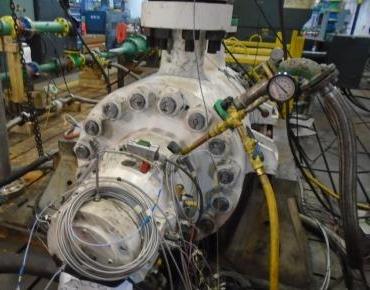
The centrifugal pump performance test is conducted by pump manufacturer after completion of the assembly to prove the pump has the required specification as indicated in the pump datasheet and other purchase documents.
The performance test is conducted after completion of casing inspection , casing hydrostatic test , impeller , and rotor dynamic balancing. The NPSH test , mechanical running test , and final inspection are done after performance test. The vibration testing is carried out during performance test and mechanical running test. You may also want to review a general centrifugal pump inspection and test procedure .

Let explain the performance test by an example. You are attending to the pump manufacturer shop to witness a centrifugal pump performance test which is a hold point on the pump ITP. You review the pump approved datasheet and find following information:
Rate flow = 238.5 m³/h (1050.08 Gal/Min)
Rated Differential Head = 2690.28 m (8826.37 feet)
Rated Power = 2985 KW (4003 HP)
Rated Efficiency = 68 %
Upon completion of the centrifugal pump performance test, the pump manufacturer provides you following performance curve. You need to match this curve with datasheet specification to make sure the pump passed the performance test.
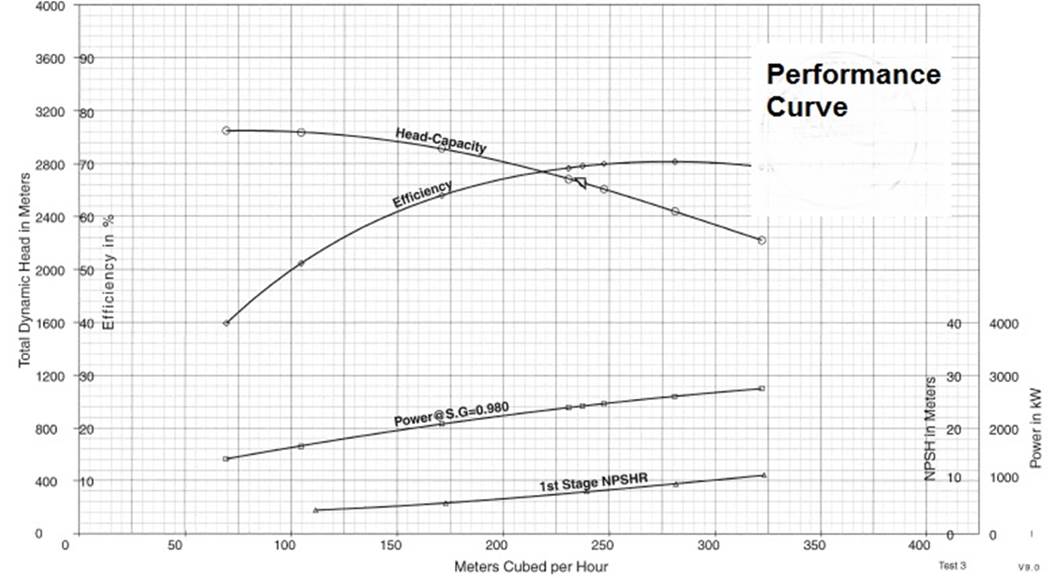
Let's start with head-capacity curve, we draw a verticle line at 238.5 (in the horizontal axis), and it will cross head-capacity curve, then we draw a horizontal line from the cross point, and it crosses the vertical axis at 2640. So the measured head at the 238.5 m³/h is 2640 meter.
What was expected value in the datasheet? It was 2690.28 m but the test result was 2640 m.
What is the test result ( the head almost is 50.28 meters less than required value)? The pump outperforming or underperforming?
The API 610 at table 18 says the head can be +/- 3% of the rated value. The 3 % of the rated value (2690.28 x 3%) would be 80.7 which is greater than 50.28, the pump underperforming but the test result is acceptable.
Let's assess the power consumption; we repeat the same process but this time with the power curve. The curve indicates the consumed power at 238.5 m³/h is 2600KW (power consumption was provided at the left side of the vertical axis). Compare 2600 KW with datasheet value which is 2985 KW.
Obviously, the pump outperforming since consumes less power. However, API 610 acceptance range is 4% it means the pump test result would be satisfactory even if consumes more than 4 % from what indicated in the datasheet.
We also need to check the efficiency. The minimum efficiency in the approved datasheet is 68 %. Check the efficiency curve, the efficiency amount at the 238.5 m³/h is 70%. So the pump is outperforming and gives higher efficiency than what required in the datasheet.
So the result of the centrifugal pump performance test for the differential head, power consumption, and efficiency is satisfactory.
The head value also shall be checked in shut off point but since this pump is high energy pump, the centrifugal pump performance test at the shut-off point (no flow at discharge valve) is not a requirement based on API 610.
The above example was a simplified example. The pump manufacturers usually provide a tabulated format to make it easy for review.
The manufacturers also simulate the test result to actual field condition. The pump might be designed for crude oil, but in the shop will be tested by the water. In such cases, the attained values will be converted to field condition by engineering calculation.
Subsequently, you need to check bearing housing and shaft vibration FFT spectrum (Plot) at each data point from minimum to maximum flow to ensure the vibration values are within acceptance range.
The Pump NPSH Test (Net Positive Suction Heat Test) report also shall be verified against approved datasheet values.
The pump mechanical running test is performed after successful completion of performance and NPSH test.
Now let deepen in the centrifugal pump performance test by the understanding of flowrate, total head, power, and efficiency.
Volume flow rate (Q), also referred to as capacity, is the volume of liquid that travels through the pump in a given time (measured in gallons per minute or GPM).
It defines the rate at which a pump can push fluid through the system. Flowrate is the first parameter specified by the process designer, who determines the pump requirement on the flowrate that the process needs to function.
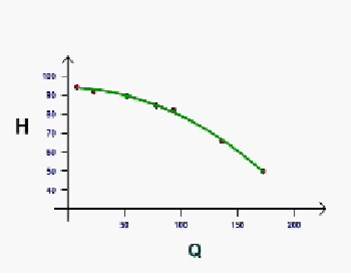
This 'rated' flowrate is normally expressed in volume terms, and it is represented by the symbol q, with units of cubic meters/ second or GPM.
The static head of a pump is the maximum height (pressure) it can deliver. The capability of the pump at a certain RPM can be obtained from its Q-H curve.
The pump manufacturers are interested in providing pump performance curve in a way that does not depend on to the pumped fluid physical properties.
That is why they are using head instead of pressure. The following formula converts pressure to the head; H(meter) = 10.2 P/SG or H(feet)= 2.3P/SG
Once the rated flowrate has been determined, the designer subsequently specifies the total head (H) needed at this flowrate.
This is expressed in meter or feet and represents the usable mechanical work transmitted to the fluid by the pump. Together q and H define the duty point.
The q/H Curve Test;
The test is carried out at a nominally constant shaft speed, and the head (H) decreases as flowrate (q) increases, giving a negative slope to the curve. (See above H-Q curve)
Look at the following sketch; this illustrates a simple H-Q curve loop. The test engineer changes the flowrate through discharge control valve and takes measurement of different variables and calculates the corresponding head.
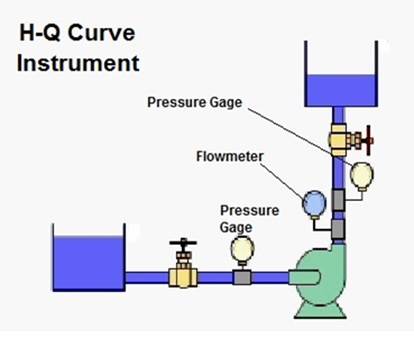
The first set of measurements is taken at duty point (100 percent q). The valve is opened to give a flowrate greater than the duty flow (normally 120 or 130 percent q), and further readings are taken.
The valve is then closed in a series of steps, progressively decreasing the flow (note that we are moving from right to left on the Q-H curve). With some pumps, the final reading can be taken with the valve closed, i.e. the q = 0 or shut-off condition.
Once the test points are obtained, you can now check against the acceptance criteria requirements
The power consumption is measured at different flowrates similarly, and the power-flowrate curve is plotted. A wattmeter is connected to motor power input, by multiplying wattmeter amount at motor efficiency the motor output power is calculated at different flowrates. Through these corresponding readings, the power-flowrate curve is plotted.
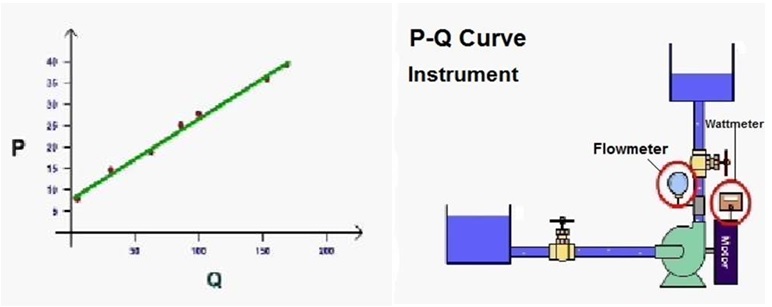
The efficiency-flowrate (ƞ-Q) curve can be plotted based on measured values from combination of H-q curve and P-q curve and this formula ƞ=(P out of Pump)/(P input of Pump)=ρgHQ/(P input of pump) (ρ is density, g is gravitational acceleration, H is Head and Q is Flowrate)
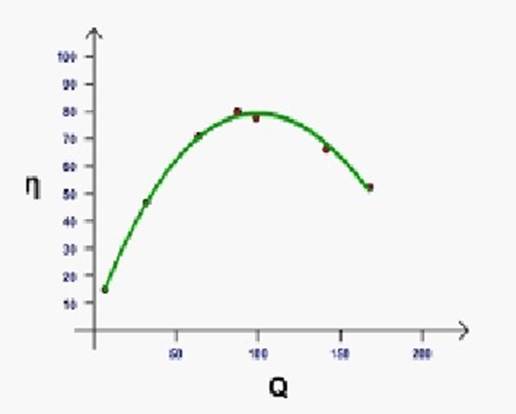
Pump efficiency (ƞ percent): the efficiency is the ratio of transferred mechanical work of the fluid to consumed power (P) in watts by the pump.
The efficiency test; the efficiency is checked using the same set of test measurements as the q/H test. Pump efficiency is plotted against q in above figure.
This content provides you with a sample Centrifugal Pump Performance Test Procedure in the manufacturing shop. The procedure is very brief and general.
Centrifugal Pump Performance Test Procedure
This description of procedure defines the conditions for the hydraulic testing of centrifugal pumps according to API Standard 610.
Scope of test, type of test, test class and guarantee values are defined by standardized test plans agreed between pump manufacturer and pump purchaser.
Objective of the tests is the continuous control of performance data as process control, keeping the guarantees given according to the supply agreement, testing of relevant pump functions.
Preparation of test reports and test curves according to the supply agreement as integral part of the test documentation.
3. Standards and Other Regulations Applicable
4. Centrifugal Pump Performance Test procedure
4.1 Testing Personnel
For the handling of the test beds, only trained personnel is employed. The setting of test data is done semi-automatically and requires appropriate test experience and accuracy.
4.2 Place and Time Of Testing
The testing is done on the test bay of the manufacturer. Only pure cold water with a density of ρ= 1 kg/dm3 is used as the test medium.
Pump block units are normally tested with installed motor. In case of acceptance by the customer, the readiness for the acceptance inspection is notified in time to the sales departments.
4.3 Pump Test Beds
Both of following test beds are available and will be utilized as per purchase order specification
4.4 Measurement And Testing Methods
The measurement and evaluation of hydraulic characteristic values is made by means of an electronic data logger.
All relevant data are recorded at the site by means of electronic measuring devices and presented with online electronic data processing at the test sites. After termination of the measurements, the data is transferred to the central computer of the test bay supervision. Unless otherwise specified, the acceptance performance tests are carried out in acc. with API 610, para. 7.3.3.
4.4.1 Measurements Of Flow Rate Q
The flow rate is measured using magnetic inductive flow measuring devices having the specified stabilization distances in front and after the measuring unit. The setting of the capacity is effected by control valves in the discharge pipe.
4.4.2 Measurement of head H (Hd - Hs)
Pressure measurements are made using calibrated measuring transmitters for the measuring point Hs (measuring range -10 up to +40 m wc), for measuring point Hd (measuring range -10 up to +180 m, 150 up to 630 m wc). For visual comparison, calibrated spring manometers are connected in parallel for analogous display.
4.4.3 Measurement of Velocity Head
The velocity head is calculated using the flow rate and the flow cross-section at the pressure measuring point.